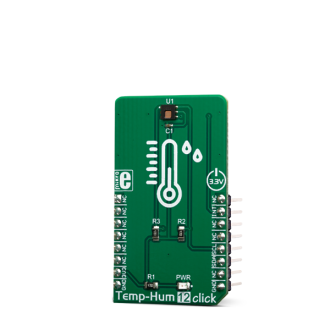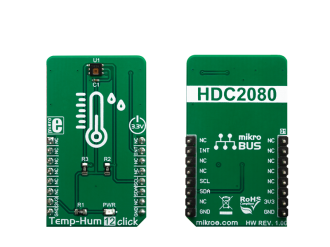
We strongly encourage users to use Package manager for sharing their code on Libstock website, because it boosts your efficiency and leaves the end user with no room for error. [more info]

Rating:
Author: MIKROE
Last Updated: 2019-04-01
Package Version: 1.0.0.0
mikroSDK Library: 1.0.0.0
Category: Temperature & humidity
Downloaded: 4403 times
Not followed.
License: MIT license
Temp-Hum 12 click is a smart environmental temperature and humidity sensor Click board, packed with features which allow easy and simple integration into any design that requires accurate and reliable humidity and temperature measurements.
Do you want to subscribe in order to receive notifications regarding "Temp-Hum 12 click" changes.
Do you want to unsubscribe in order to stop receiving notifications regarding "Temp-Hum 12 click" changes.
Do you want to report abuse regarding "Temp-Hum 12 click".


Library Description
The library initializes and defines the I2C bus driver and drivers that offer a choice for writing data in register and read data form register. The library includes function for read Temperature and Relative Huminidy data and function for read device ID and Manifactures ID. The user also has the function for configuration chip for measurement and read Interrupt (INT pin) state.
Key functions:
float temphum12_getTemperature(uint8_t tempIn) - Temperature datafloat temphum12_getHumidity() - Relative Huminidy dataExamples description
The application is composed of the three sections :
void applicationTask()
{
float Temperature;
float Humidity;
char demoText[ 50 ] = {0};
Temperature = temphum12_getTemperature(_TEMPHUM12_TEMP_IN_CELSIUS);
FloatToStr(Temperature, demoText);
mikrobus_logWrite(" Temperature : ", _LOG_TEXT);
mikrobus_logWrite(demoText, _LOG_LINE);
Delay_1sec();
Humidity = temphum12_getHumidity();
FloatToStr(Humidity, demoText);
mikrobus_logWrite(" Humidity : ", _LOG_TEXT);
mikrobus_logWrite(demoText, _LOG_LINE);
mikrobus_logWrite("-------------------------", _LOG_LINE);
Delay_1sec();
}
Other mikroE Libraries used in the example:
I2CUARTConversionsAdditional notes and informations
Depending on the development board you are using, you may need USB UART click, USB UART 2 click or RS232 click to connect to your PC, for development systems with no UART to USB interface available on the board. The terminal available in all MikroElektronika compilers, or any other terminal application of your choice, can be used to read the message.